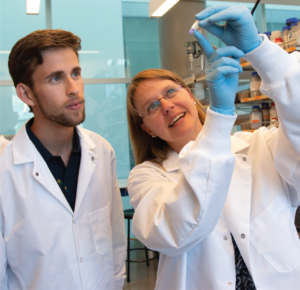 A team of University of Utah biomedical engineering researchers led by associate professor Tara Deans has found a new way to control gene expression in bacteria using genetic parts from higher organisms. Before, synthetic biologists have typically moved genetic parts from bacteria up to eukaryotes like yeast and mammalian cells.
A team of University of Utah biomedical engineering researchers led by associate professor Tara Deans has found a new way to control gene expression in bacteria using genetic parts from higher organisms. Before, synthetic biologists have typically moved genetic parts from bacteria up to eukaryotes like yeast and mammalian cells.
The ability to engineer bacteria has wide applications. In addition to producing therapeutic proteins, efforts are being made to engineer commensal bacteria – the bacteria that naturally live in humans – to treat digestive disorders, kidney disease, and even cancer.
In a paper published in Nature Communications this month, the U team demonstrated that genetic parts naturally found in yeast can be moved to bacteria to control the production of protein. Moving these genetic parts to bacteria enables the control of either extremely high levels of protein production or the ability to completely turn it off. Bacteria are often used to make high levels of protein, like insulin, for treating various diseases and disorders. Improving the production of therapeutic proteins will lower the cost of their production, which has the potential to make more medications accessible.
“We demonstrated that eukaryotic genetic parts can be used to reprogram bacteria with novel functions,” Deans said. “This opens the door for mining eukaryotes for new parts to function in bacteria that will expand the genetic toolbox for independently controlling genes in bacteria.”
In addition to Deans, the paper was co-authored by U biomedical engineering Ph.D. students Cody MacDonald, Jonathan Emmons and Shwan Javdan, and undergraduate student Travis Seamons (pictured above, left, with Deans). The Deans Lab for Applied Synthetic Biology focuses on building genetic tools, called synthetic gene circuits, to reprogram cells to perform useful functions.
Like most engineers, building new structures and devices involve assessing a toolbox of different parts and finding ways to put them together. More tools inside the toolbox increases the possibilities and complexities of new structures and devices.
“We demonstrate in our work that we can completely turn off the expression of a gene. This will be essential for engineering therapeutic commensal bacteria because it will be important to keep therapeutic proteins off until they are needed” said Seamons.
“Working on this project has been an amazing honor,” he added. “I love going into the lab knowing that I might learn something no one else has ever known before. Our findings open the door to new strategies for engineering bacteria. I’m excited to continue working on this project and making new discoveries.”
In the paper, the authors investigate a number of genetic devices in bacteria using these new tools to control gene expression originally identified in yeast. These devices include sensors with a stronger output signal that can be used for diagnostics and a method to produce 30 to 40 times more mRNA and protein than current methods.
Messenger RNA, or mRNA, is a type of single-stranded RNA molecule that became the basis of the two leading vaccines used by Pfizer and Moderna in the fight against COVID-19. With the emergence of mRNA-based vaccines as a therapeutic intervention, it is possible that these new genetic tools can be used to produce high levels of mRNA and protein for various biotechnology applications.